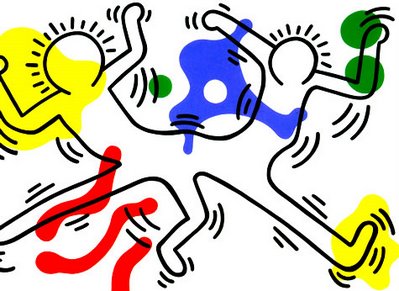Pop Art, a term invented by critic Lawrence Alloway, was a style that developed in the US and the UK in the 1950s and 60s which used mass and commercial culture as its key elements. Adherent artists emphasized ironies within contemporary, mass-produced and consumed life and rejected what they saw as elitist tendencies in the fine arts.
 Among these social critics was Keith Haring (1958-1990), who studied at the Ivy School of Professional Art in Pittsburgh and the School of Visual Arts in New York City. He was mesmerized by the graffiti of New York City, which became his dominant motif. Haring opened Pop Shops -- stores dedicated to selling his merchandise. He died in 1990 of AIDS.
Among these social critics was Keith Haring (1958-1990), who studied at the Ivy School of Professional Art in Pittsburgh and the School of Visual Arts in New York City. He was mesmerized by the graffiti of New York City, which became his dominant motif. Haring opened Pop Shops -- stores dedicated to selling his merchandise. He died in 1990 of AIDS. Moses and the Burning Bush (1985).
Moses and the Burning Bush (1985). Two Dancing Figures (1989).
Two Dancing Figures (1989). Untitled (1986).
Untitled (1986). Pisa Mural, on the Church of Sant Antonio in Pisa, Italy (1989).
Pisa Mural, on the Church of Sant Antonio in Pisa, Italy (1989).

3 comments:
Thanks for being brave enough to post about his work.
He, in his art work, gives recognition to the innate creative beauty and worth of every human. Though a strong and central "theme" comes through about his life, his art remains a common human bond that declares, for a moment, all other considerations irrelevant. I may disagree about that which was signified, yet I only find delight in the signifier.
Thank you, J2, although I am unsure about the meaning of anything presented above except for Moses and the Burning Bush.
Not to pigeon hole(no pun intended) every piece of his work, but he was not shy about revealing his inner self and its unbridled longing to connect to the other/whatever. This essay might capture best why I think it is brave for you to bring attention to his work:
http://www.haring.com/cgi-bin/essays.cgi?essay_id=09
Post a Comment